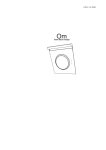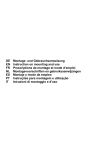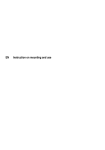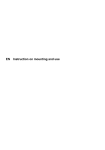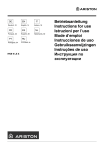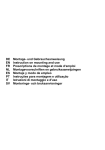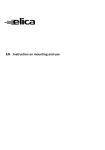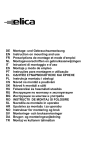Download Design Team Elica
Transcript
LI2YDH Ed. 03/08 Star Design Team Elica EN - Instruction on mounting and use Consult the designs in the front pages referenced in the text by alphabet letters. Closely follow the instructions set out in this manual. All responsibility, for any eventual inconveniences, damages or fires caused by not complying with the instructions in this manual, is declined. The symbol on the product, or on the documents accompanying the product, indicates that this appliance may not be treated as household waste. Instead it should be taken to the appropriate collection point for the recycling of electrical and electronic equipment. Disposal must be carried out in accordance with local environmental regulations for waste disposal. For more detailed information about treatment, recovery and recycling of this product, please contact your local council, your household waste disposal service or the shop where you purchased the product. Caution WARNING! Do not connect the appliance to the mains until the installation is fully complete. Before any cleaning or maintenance operation, disconnect the hood from the mains by removing the plug or disconnecting the home mains switch. The appliance is not intended for use by children or persons with impaired physical, sensorial or mental faculties, or if lacking in experience or know-how, unless they are under supervision or have been trained in the use of the appliance by a person responsible for their safety. Children should be monitored to ensure that they do not play with the appliance. Never use the hood without effectively mounted grating.! The hood must NEVER be used as a support surface unless specifically indicated. The premises must be sufficiently ventilated, when the kitchen hood is used together with other gas combustion devices or other fuels. The suctioned air must not be conveyed into a conduit used for the disposal of the fumes generated by appliances that combust gases or other fuels. The flaming of foods beneath the hood itself is severely prohibited. The use of exposed flames is detrimental to the filters and may cause a fire risk, and must therefore be avoided in all circumstances. Any frying must be done with care in order to make sure that the oil does not overheat and burst into flames. As regards the technical and safety measures to be adopted for fume discharging it is important to closely follow the relations provided by the competent authorities. The hood must be regularly cleaned on both the inside and outside (AT LEAST ONCE A MONTH, it is in any event necessary to proceed in accordance with the maintenance instructions provided in this manual).. Failure to follow the instructions as concerns hood and filter cleaning will lead to the risk of fires. Do not use or leave the hood without the lamp correctly mounted because of the possible risk of electric shocks. We decline any responsibility for any problems, damage or fires caused to the appliance as the result of the nonobservance of the instructions included in this manual. This appliance is marked according to the European directive 2002/96/EC on Waste Electrical and Electronic Equipment (WEEE). By ensuring this product is disposed of correctly, you will help prevent potential negative consequences for the environment and human health, which could otherwise be caused by inappropriate waste handling of this product. Use The hood has been made for use in the internal recirculating filtering version. Cooking fumes and steam are aspirated inside the hood, filtered and cleaned, passing through the fat filter/s and the carbon filter/s that MUST be supplied with the hood. Attention! If the hood is not supplied with carbon filter, then it must be ordered and mounted. Installation Specialised personnel must carry out both the electrical and the mechanical installation. The minimum distance between the supporting surface for the cooking vessels on the hob and the lowest part of the range hood must be not less than 50cm from electric cookers and 70cm from gas or mixed cookers. If the instructions for installation for the gas hob specify a greater distance, this must be adhered to. Electrical connection The mains tension must correspond to the tension shown on the characteristic label situated inside the hood. The product is meant for connecting directly to the mains supply, therefore apply a regulation bipolar switch that ensures complete disconnection from the mains in the conditions of category III over-tension, conforming to the installation rules. ATTENTION! Detail B (fixing bracket to the ceiling - Fig. 1) is equipped with a conductor (yellow-green) that must be connected to the earth of the domestic electrical plant. Fig. 4 ATTENTION! Be particularly careful about positioning the excess cable. Failure to observe this indication could cause grave damage to the apparatus and/or an electric shock to the user or the installer. For further details see Fig. 8 Attention! Changing the interconnection cable must be carried out by the authorised technical assistance service. 10 Mounting Hood in stand-by: LED OFF 1st suction speed (power) - led GREEN 2st suction speed (power) - led ORANGE (amber) 3st suction speed (power) - led RED 4st suction speed (power) - led RED (FLASHING) Note: the 4th aspiration speed (power) remains on for 5 minutes after which the aspiration motor positions itself on the 2nd speed. Touched once more, the suction motor switches off (Standby). Expansion wall plugs are provided to secure the hood to most types of walls/ceilings. However, a qualified technician must verify suitability of the materials in accordance with the type of wall/ceiling. The wall/ceiling must be strong enough to take the weight of the hood. Do not tile, grout or silicone this appliance to the wall. Surface mounting only. Description of the hood Fig. 1 H. Interconnection cable K. Control lever Attention! The control lever is already supplied. It is to be installed last, before connecting the hood to the mains. Insert the control lever into the apposite housing (see drawings on the first pages of this booklet - triggered connection, compulsory direction. L. Halogen bulb M. Lateral filter holder frame N. Active carbon filter O. Metal anti-fat filter P. Anti-fat and carbon filters holder frame Q. Filter holder frame releases Need to wash the anti-fat filter: GREEN led FLASHING (read the instructions relative to “Reset and configuration of the filters saturation signal") Need to wash or replace the carbon filters: ORANGE (amber) led FLASHING (read the instructions relative to “Reset and configuration of the filters saturation signal”) Note: reset can be carried out both with the control lever and the remote control. Control of the central light The central light can be switched on and off by touching the LOWER PART of the control bar BRIEFLY. Control of the lateral lights (when envisaged) The lateral lights can be switched on and off by touching IN A PROLONGED MANNER the LOWER PART of the control lever. The PROLONGED TOUCH allows, other than switching on and off, adjusting the intensity of the light emitted by the lamp. Note: The functions of switching and off (and adjustment) alternate. The light intensity regulation feature is not available for hoods with neon lights. Operation Use the high suction speed in cases of concentrated kitchen vapours. It is recommended that the cooker hood suction is switched on for 5 minutes prior to cooking and to leave in operation during cooking and for another 15 minutes approximately after terminating cooking. The hood is equipped with a “TOUCH SENSOR” device able to determine the control of the lights and the speed when the user touches the control bar. Read the instructions below carefully for this purpose. The cooker hood can be controlled through a remote control available as accessory kit (see the paragraph relating to the functioning of the remote control). Automatic switch-on function The hood is equipped with a temperature sensor that starts the motor at the 1st suction speed (power) when the room temperature around the hood is higher than 70°C. The user can, however, switch off or modify the suction speed (power). (See paragraph “Control of suction speed (power))”. Reset and configuration of the filters saturation signal Switch the hood on at any speed (see paragraph above “Selection of the suction speed (power)” Reset anti-fat filter saturation signal (GREEN LED FLASHING on the control level) First proceed with the maintenance of the filter as described in the corresponding paragraph. Touch in a prolonged manner (more than 3 seconds) the UPPER PART of the control lever, the LED stops flashing to indicate that the reset of the signal has been carried out and the hood switches off. Control of suction speed (power) The selection of the suction speed (power) is cyclical, according to the speed sequences “”stand-by - 1-2-3-4- Stand by -1-2-”… so that at every touch of the UPPER PART of the control bar the suction speed (power) increases by a level and then to switches off (stand-by) if the control bar is touched again when the hood is at suction speed (power) 4. It is possible lo turn the hood off (standby) even when the hood is at any speed by pressing the UPPER PART of the control bar (for more than 3 seconds). It is possible to determine what suction speed (power) the hood is in when the bar is equipped with a led that changes colour on the basis of the suction speed (power), as follows: Reset anti-fat filter saturation signal ORANGE (amber) LED FLASHING First proceed with the maintenance of the filter as described in the corresponding paragraph. Touch in a prolonged manner (more than 3 seconds) the UPPER PART of the control lever, the LED stops flashing to indicate that the reset of the signal has been carried out and the hood switches off. 11 Resetting the anti-fat filter saturation signal (GREEN LED FLASHING on the control bar) First proceed with the maintenance of the filter as described in the corresponding paragraph. Press the “+” and “-” keys contemporaneously for about 3 seconds. The LED stops flashing, indicating that the resetting of the signal has been accomplished. Deactivating the carbon filter saturation signal (for special applications) Switch the hood off (see paragraph above “Select the suction speed power”) Touch in a prolonged manner (more than 5 seconds) the UPPER PART of the control lever, the LED flashes in GREEN to indicate that the carbon filter saturation signal has been deactivated. To reactivate the carbon filter saturation signal, repeat the operation. The LED flashes in ORANGE (amber). Resetting the carbon filter saturation signal (ORANGE (amber) LED FLASHING) Note! The reset of the carbon filter saturation signal is normally deactivated. To activate it, see under paragraph “Activating the carbon filter saturation signal”. First proceed with the maintenance of the filter as described in the corresponding paragraph. Press the “+” and “-” keys contemporaneously for about 3 seconds. The LED stops flashing, indicating that the resetting of the signal has been accomplished. Using the remote control The remote control is able to control all the functions of the hood: Select the suction speed (power) Control the central light Control the lateral lights Deactivating the carbon filter saturation signal (for special applications) Switch the hood off (see paragraph above “Selecting the suction speed (power)”). Press the "◄" key or the "►" key until seeing the symbol relating to the “Resetting and configuration of the filters saturation signal” function on the remote control. Press keys “+” and “-” contemporaneously for about 3 seconds. The LED flashes in GREEN to indicate that the carbon filter saturation signal has been deactivated. To reactivate the carbon filter saturation signal, repeat the operation. The LED flashes in ORANGE. Reset e configure the saturation of the filters signal Selecting the suction speed (power): Press the "◄" key or the "►" key until you see the symbol relating to the “Select the suction speed (power)” function. Press the “+” key or the “-” key or the "■" key respectively to increase or diminish or switch off (stand-by) the speed (suction power). Controlling the central light: Press the "◄" key or the "►" key until seeing the symbol relating to the “Controlling the central light” function on the remote control. The central light can be switched on and off in two ways: 1. Press the “+” key or the “-” key respectively to switch the central light (ON) or (OFF). 2. Press the "■" key to change the state of the light from (OFF) to (ON) or vice versa. Maintenance of the remote control Cleaning the remote control: Clean the remote control with a damp cloth and a neutral solution of detergent without abrasive substances. Changing the battery: • Open the battery casing using a small screwdriver with a flat point. • Change the finished battery with a new one of 12 V type MN21/23 In inserting the new battery respect the polarity indicated on the battery casing! • Close the battery casing up again. Disposal of the batteries Ultimate disposal of the batteries should be handled according to all national laws and regulations. Do not place used batteries in your regular waste. Ultimate disposal of the batteries must be done safely. Contact your local waste management officials for other information regarding the environmentally sound collection, recycling, and disposal of the batteries. Controlling the lateral lights: Press the "◄" key or the "►" key until seeing the symbol relating to the “Controlling the lateral lights” function on the remote control. Press the "■" key to change the state of the lateral lights from (OFF) to (ON) at maximum intensity and viceversa. Press the “-” key to diminish the intensity of the lateral lights until switching them off. Press the “+” key to increase the intensity of the lateral lights. Resetting and configuring the saturation of the filters signal Switch the hood on at any speed (see paragraph above “Selecting the suction speed (power”). Press the "◄" key or the "►" key until seeing the symbol relating to the “Resetting and configuration of the saturation of the filters signal” function on the remote control. 12 Maintenance Replacing lamps Before performing any maintenance operation, isolate the hood from the electrical supply by switching off at the connector and removing the connector fuse. Fig. 14 Disconnect the hood from the electricity. Warning! Prior to touching the light bulbs ensure they are cooled down. To replace the central lamp: use only 40W max 40° D25 GU10.halogen lamps. Removing the bulb: rotate anti-clockwise a quarter turn and take out. Mounting the bulb: insert the bulb in its seat so that its contacts enter the congruent seats on the bulb-holder, rotate clockwise for about a quarter turn. Some models envisage lateral lamps: Replace them with identical forms of 40W (E14) max). If the lights do not work, make sure that the lamps are fitted properly into their housings before you call for technical assistance. Cleaning The cooker hood should be cleaned regularly (at least with the same frequency with which you carry out maintenance of the fat filters) internally and externally. Clean using the cloth dampened with neutral liquid detergent. Do not use abrasive products. DO NOT USE ALCOHOL! WARNING: Failure to carry out the basic cleaning recommendations of the cooker hood and replacement of the filters may cause fire risks. Therefore, we recommend oserving these instructions. The manufacturer declines all responsibility for any damage to the motor or any fire damage linked to inappropriate maintenance or failure to observe the above safety recommendations. To clean shells A, dismantle them as in Fig. 14 and wash them by hand in hot water and neutral detersives. Grease filter Fig. 13 Traps cooking grease particles. This must be cleaned once a month (or when the filter saturation indication system – if envisaged on the model in possession – indicates this necessity) using non aggressive detergents, either by hand or in the dishwasher, which must be set to a low temperature and a short cycle. When washed in a dishwasher, the grease filter may discolour slightly, but this does not affect its filtering capacity. Charcoal filter (filter version only) Fig. 13 It absorbs unpleasant odours caused by cooking. The charcoal filter can be washed once every two months (or when the filter saturation indication system – if envisaged on the model in possession – indicates this necessity) using hot water and a suitable detergent, or in a dishwasher at 65°C (if the dishwasher is used, select the full cycle function and leave dishes out). Eliminate excess water without damaging the filter, then put it in the oven for 10 minutes at 100° C to dry completely. Replace the mattress every 3 years and when the cloth is damaged. 13













